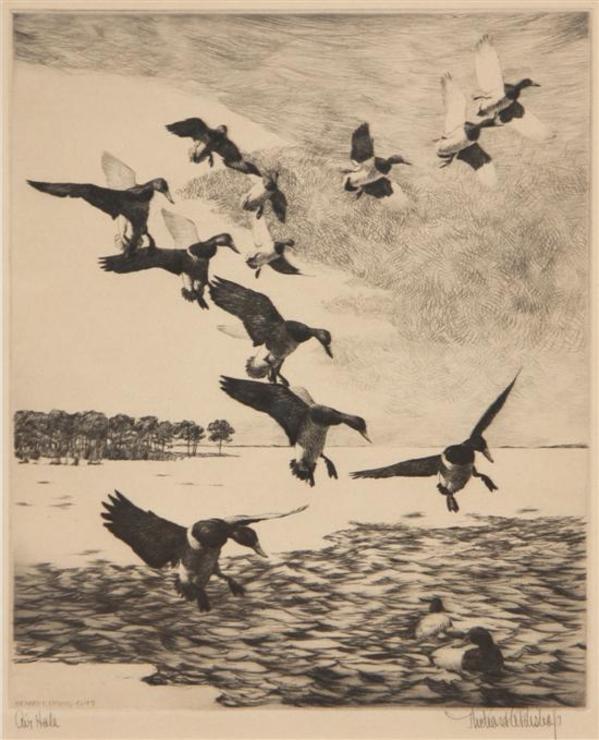-
Artist: Richard Evett Bishop (American, 1887-1975)
“Although Richard E. Bishop was best known as an artist, author, photographer, and sportsman, his formal training and first career was in engineering. He was born in Syracuse, New York on May 30, 1887, the son of a railroad man. His father was an ardent gunner of ducks and geese, and indoctrinated his son at a tender age in the religion called waterfowl hunting. After graduating from Syracuse High School, Bishop entered Cornell University and graduated in 1909 with a Masters of Engineering degree and went to work as an electrical engineer for the Cutler-Hammer Manufacturing Company in Milwaukee” (1).
“In 1915 he married the former Mary Ellen Harrington. He served as a Captain in the Army Chemical Warfare Service during World War 1, receiving his discharge in 1919” (2).
“After four years in the military, he and his wife moved to Philadelphia where he worked at a manufacturing plant as both Secretary and Sales Manager, positions he held until his retirement from business in 1933. Bishop's career as an artist began, largely by accident, in 1920. He was in charge of a plant that fabricated copper products. Discarded copper printing plates were often brought in, to be melted down and "recycled." This struck Bishop as a waste, so one day he rescued a plate, covered it with wax, and etched a portrait---human, not avian---using a phonograph needle as his stylus. Four years later, his "Canada Geese" won the Charles M. Lea prize awarded by the Philadelphia Print Club” (1).
“Although Bishop learned the basics of printmaking from the eminent graphic artist Ernest Roth of the Connecticut School, in most respects he was self-taught. He appropriated the techniques and nuances of the intaglio media---etching, drypoint, and aquatint---through trial and error, relying on his critical, engineer's eye to guide his hand. He built his own printing press for his limited editions, keeping the entire printmaking process in his own hands” (1).
“It was to be expected that his subject should be birds, for he was an enthusiastic wildfowler and a top-ranking field shot. Being an engineer as well, and a perfectionist, he wanted to portray the wing action and flight of birds as correctly as possible. High-speed photography was the answer, and with characteristic thoroughness he took thousands of feet of movie film of birds in flight at the rate of 128 frames per second. His pictures of birds are among the finest ever taken. He has applied the knowledge gained from careful study of these pictures, and from field observations and sketches, to many art media: etchings, drypoints, aqua prints, oil paintings, watercolors, jewelry, tiles, medals, glassware, and china” (2).
“Bishop was a member of the Philadelphia Print Club, the Chicago Society of Etchers, the Philadelphia Society of Etchers, the Society of American Etchers, Philadelphia Sketch Club, Philadelphia Watercolor Club, Philadelphia Art Alliance, and California Printmakers” (3).
“The artist died in 1975 at the age of 87” (3).
Reference:
1.
The Meadowlark Gallery Staff. Richard E. Bishop [internet]. [cited 2015 July 19]. Available from: http://www.meadowlarkgallery.com/BishopRichardE.htm
2.
Russell Fink Gallery Staff. Bishop, Richard E. [internet]. [cited 2015 July 19]. Available from: http://store.russellfinkgallery.com/bishopricharde.html
3.
Askart Staff. Richard Bishop [internet]. [cited 2015 July 19]. Available from: http://www.askart.com/artist_bio/Richard_Evett_Bishop/22839/Richard_Evett_Bishop.aspx
